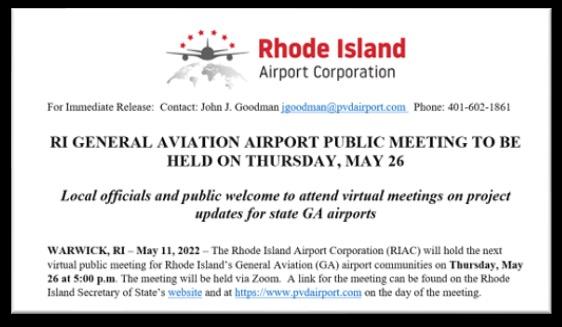
1 minute read
General Aviation Airports Communication Initiatives

The State of Rhode Island recognized that it is necessary in the interest of the public health, safety and general welfare to prevent the creation of airport hazards by enacting the Airport Zoning statutes in 1946 (RIGL § 1-3 et. seq.). In 1999, it became mandatory under State law for the cities and towns having airports to adopt, administer and enforce airport zoning regulations to prevent the creation of such hazards. Currently, seven of the ten host cities and towns have not implemented the required airport zoning regulations.

Pursuant to federal law, the Federal Aviation Administration (FAA) has the exclusive authority over airspace—no airport operator may regulate aircraft in flight. Federal law known as “Part 77” governs the Safe, Efficient Use, and Preservation of the Navigable Airspace. Part 77 allows the FAA to identify potential hazards to aviation by defining protected surfaces around airports. Airport zoning regulations by host cities and towns are the prevention and enforcement mechanism to ensure that the Part 77 surfaces are protected.

General Aviation Airports Communication Initiatives
The airport zoning regulations are the first line of defense. The second line of defense is the voluntary easement acquisition program through the FAA wherein property owners are compensated for easements to remove obstructions. The third line of defense if the voluntary easement acquisition process is not successful is utilizing the right of eminent domain for the avigation easements which is utilized at airports across the country. In Rhode Island, a group of homeowners is currently challenging the State’s ability to exercise eminent domain for avigation easements. The fourth line of defense which is currently in place at Westerly and Newport State Airports is runway displacement. If obstructions cannot be removed from the protected surfaces, the FAA requires that RIAC displace the runway threshold which reduces the length of runway available for airport users. In order to obtain FAA funding for airport improvements, the FAA expects that the runway be returned to their full intended use.









